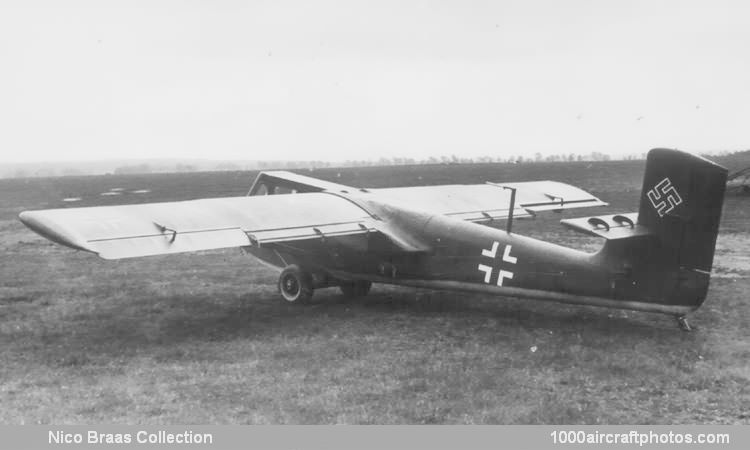07/31/2013. Remarks by Johan Visschedijk: "The Blohm & Voss BV 40 single-seat glider interceptor was a radical idea for intercepting USAAF heavy bomber formations operating by daylight. Battle experience had indicated that the frontal area of an Fw 190's radial engine - some 17 sq.ft (1.58 sq.m) - provided a target which could be hit by an average gunner at a range of more than a thousand yards.
This frontal area could only be reduced drastically by eliminating the engine, and the glider interceptor, a small heavily armed and armored glider manufactured largely from non-strategic materials and towed to attack altitude by an orthodox fighter, provided such a small target in a head-on attack that it would be virtually invisible to the bomber's gunners before it had actually opened fire with its two 1.18 in (30 mm) MK 108 cannon.
Designed by Dr.Ing. Richard Vogt, the BV 40 was selected by the RLM in the autumn of 1943 from a number of designs. Its keynote was simplicity, and the BV 40 could be built by carpenters, joiners, locksmiths and welders having no previous experience of aircraft construction. The pilot, who reclined on a padded bench, had considerable armor protection, the whole cockpit being constructed of welded sheet metal ranging from 0.787 in (20 mm) to 0.2 in (5 mm) in thickness.
The center fuselage was of metal, and the aft fuselage, wings and tail surfaces were of wood. A simple, twin-wheel bogie was employed for take off, being jettisoned immediately the 'glide-fighter' had left the ground, and the landing was effected on a semi-retractable skid. Armor protection accounted for some 26% of the aircraft's weight, and it was proposed that the BV 40 be towed to operational altitude by a Bf 109 G fighter, released from the towplane at 800-2,400 ft (244-732 m) above the bomber formation, and attack the selected bomber head-on in a 20° angle dive.
The original scheme proposed that, after the initial cannon attack, the BV 40 pilot would select a second bomber and attack this with a device known as 'Gerät Schlinge', a wire cable suspended from the glider and carrying a small explosive charge. However, this device was abandoned as its installation necessitated the deletion of one of the 1.18 in (30 mm) cannon.
Nineteen prototypes (V1 to V19) and 200 production BV 40s were ordered, and the BV 40 V1 made its first flight at the end of May 1944 towed behind a Bf 110. After modifications, a second flight test was made on June 2, 1944 at Wenzendorf airfield, but the pilot lost control and the prototype crashed. The second prototype, the BV 40 V2, flew on June 5th, the third prototype was tested to destruction, and four additional prototypes had been flown when the program was abandoned in the autumn of 1944."
